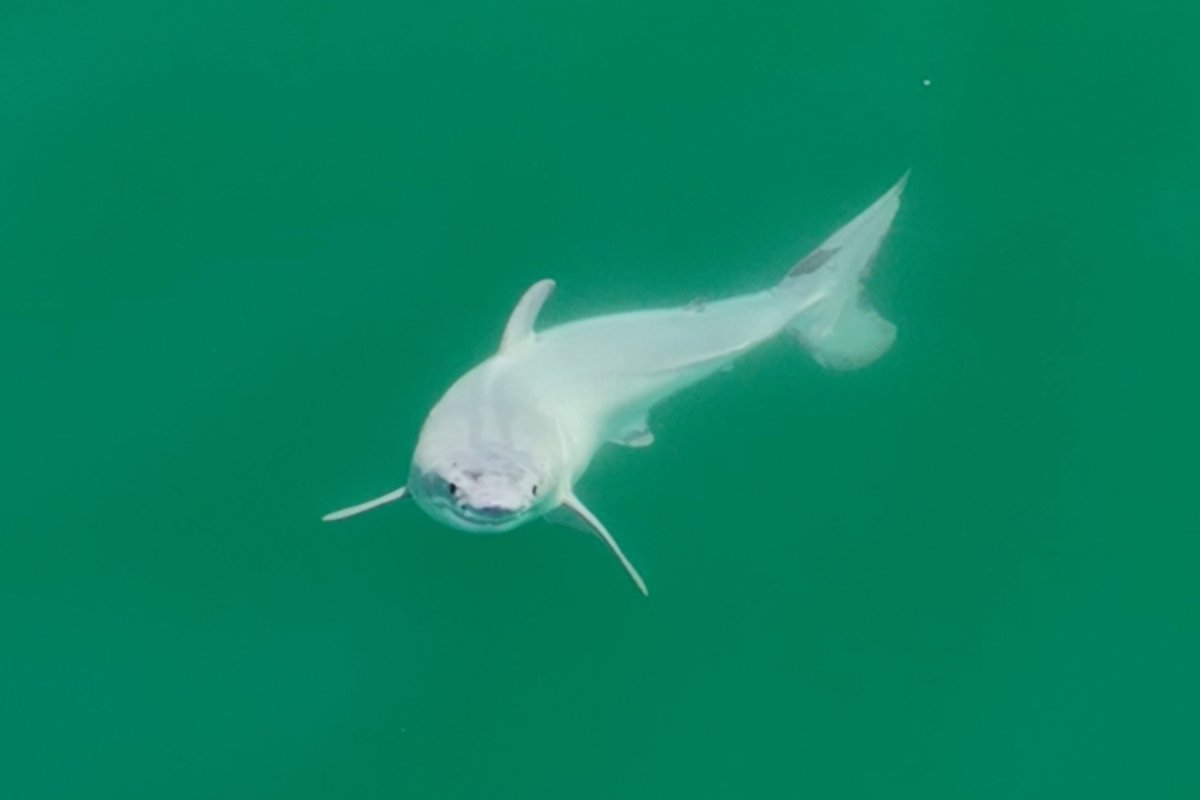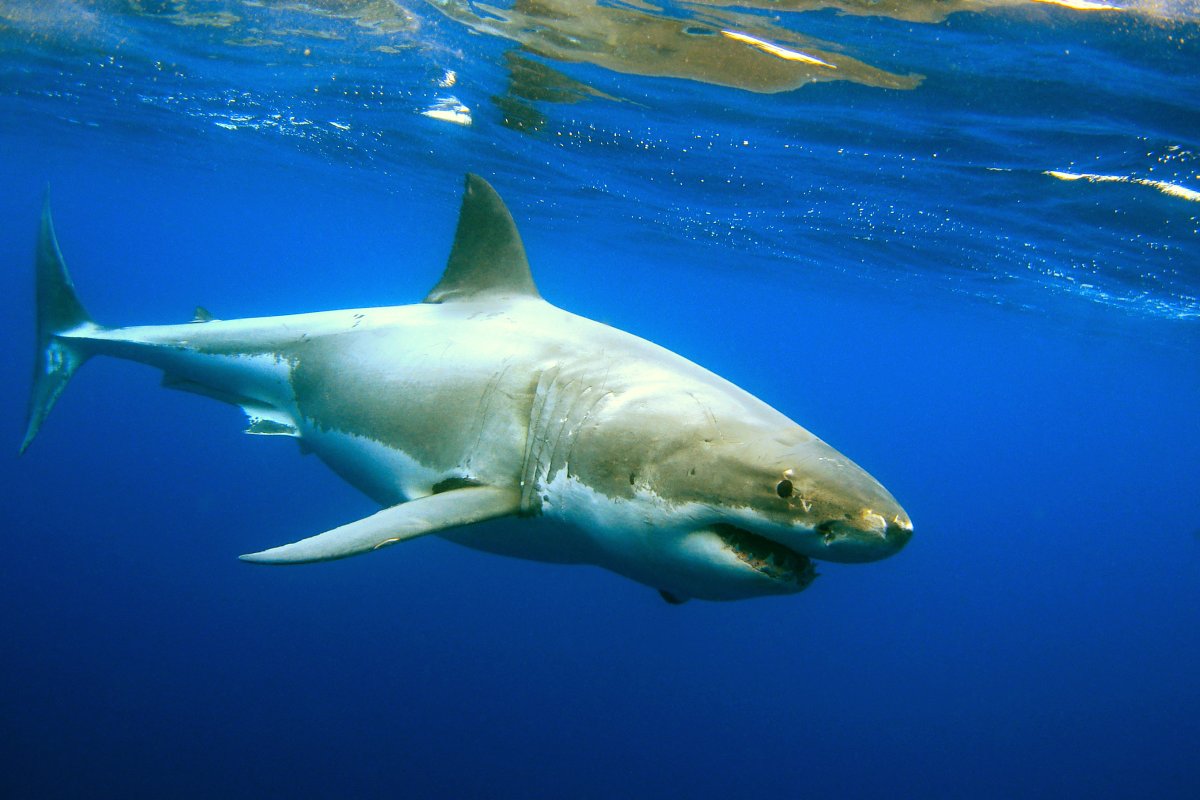For the first time, a live baby great white shark has been spotted in the wild.
The shark was around 5 feet long already and pure white, unlike its grey-colored adult counterparts, leading scientists to believe it could be a baby great white, according to a new paper discussing the finding in the journal Environmental Biology of Fishes.
Great white sharks, known to scientists as white sharks, have never before been observed as juveniles, with their mating and reproduction being a long-standing mystery to marine biologists.
"Where white sharks give birth is one of the holy grails of shark science. No one has ever been able to pinpoint where they are born, nor has anyone seen a newborn baby shark alive," wildlife filmmaker Carlos Gauna, who was one of the pair that spotted the shark, said in a statement. "There have been dead white sharks found inside deceased pregnant mothers. But nothing like this."

The baby shark was sighted off the coast of Santa Barbara, California, on July 9, 2023, by Guana and Phillip Sternes, a UC Riverside biology doctoral student, who captured the rare occurrence on a drone camera.
"We enlarged the images, put them in slow motion, and realized the white layer was being shed from the body as it was swimming," Sternes said in the statement. "I believe it was a newborn white shark shedding its embryonic layer."
Great white sharks can grow to lengths of 16 feet and are listed as "vulnerable" worldwide and "critically endangered" in Europe on the IUCN Red List. These sharks give birth to live young, with the shark fetuses feeding on a sort of "milk" within their mothers' wombs. This is what the researchers believe they saw surrounding the shark pup, giving it the white color.
The size and shape of the white-colored shark is around what would be expected for a newborn great white.
"The key component here is the shape of the underdeveloped dorsal fin. It's unmistakably a very young shark," Guana told Newsweek. "The size of the shark is well within the newborn size range, and the white layer covering the shark indicates that it was possibly just birthed. We witnessed the shark shedding the layer right before our eyes. I look at the paper's explanations in terms of probabilities.
"What we do know is that unborn white sharks have been photographed inside deceased mothers in the past. There is a record of this. You can take the image of this shark and place it next to an unborn white shark in the scientific record, and they look virtually the same. What we have never had is an image of a live newborn white shark."
"In my opinion, this one was likely hours, maybe one day old at most," Sternes said in the statement.
Another piece of evidence supporting this shark being a juvenile is the location: pregnant sharks had previously been observed in the same area, indicating that this may be a popular spot for the sharks to give birth.
"I filmed three very large sharks that appeared pregnant at this specific location in the days prior. On this day, one of them dove down, and not long afterwards, this fully white shark appears," Gauna said. "It's not a stretch to deduce where the baby came from."
It was previously thought that great whites gave birth further out to sea, but this juvenile was spotted only around 1,000 feet from land, indicating that they may instead give birth in shallow waters. This area may, therefore, be a contender for research into great white shark reproduction and birth.

"There are a lot of hypothetical areas, but despite intense interest in these sharks, no one's seen a birth or a newborn pup in the wild," Sternes said. "This may well be the first evidence we have of a pup in the wild, making this a definitive birthing location."
In the paper, the authors note that it is possible that the shark's white color may not be because it was a juvenile but instead due to a skin condition of some form. However, they are fairly certain that it was indeed a newborn great white.
"If that is what we saw, then that too is monumental because no such condition has ever been reported for these sharks," Gauna said.
"Further research is needed to confirm these waters are indeed a great white breeding ground. But if it does, we would want lawmakers to step in and protect these waters to help white sharks keep thriving," Sternes said.
Do you have a tip on a science story that Newsweek should be covering? Do you have a question about great white sharks? Let us know via science@newsweek.com.
Update 1/30/24, 12:10 p.m. ET: This story was updated with comment from Carlos Gauna.
Uncommon Knowledge
Newsweek is committed to challenging conventional wisdom and finding connections in the search for common ground.
Newsweek is committed to challenging conventional wisdom and finding connections in the search for common ground.
About the writer
Jess Thomson is a Newsweek Science Reporter based in London UK. Her focus is reporting on science, technology and healthcare. ... Read more
To read how Newsweek uses AI as a newsroom tool, Click here.








